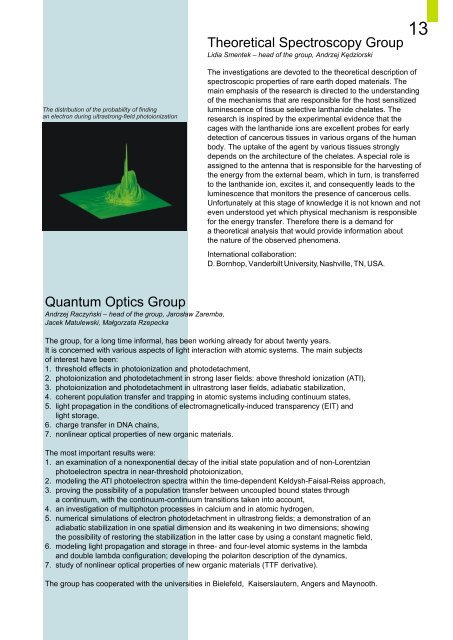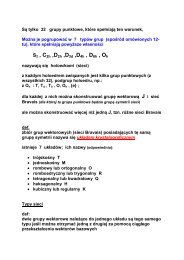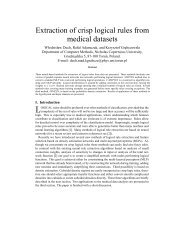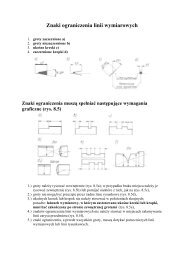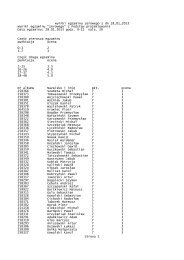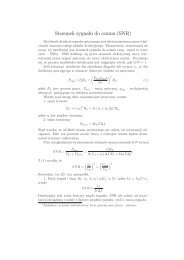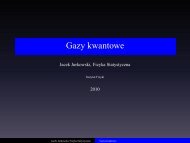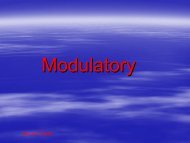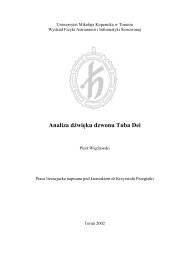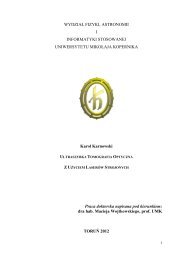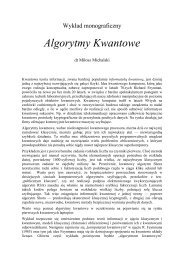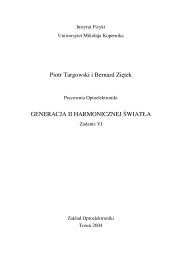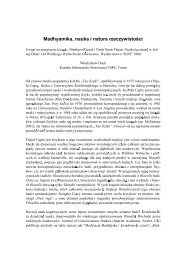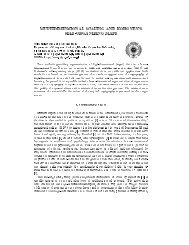Physics at Nicolaus Copernicus University
Physics at Nicolaus Copernicus University
Physics at Nicolaus Copernicus University
You also want an ePaper? Increase the reach of your titles
YUMPU automatically turns print PDFs into web optimized ePapers that Google loves.
The distribution of the probability of finding<br />
an electron during ultrastrong-field photoioniz<strong>at</strong>ion<br />
Quantum Optics Group<br />
Andrzej Raczyñski – head of the group, Jaros³aw Zaremba,<br />
Jacek M<strong>at</strong>ulewski, Ma³gorz<strong>at</strong>a Rzepecka<br />
Theoretical Spectroscopy Group<br />
Lidia Smentek – head of the group, Andrzej Kêdziorski<br />
The investig<strong>at</strong>ions are devoted to the theoretical description of<br />
spectroscopic properties of rare earth doped m<strong>at</strong>erials. The<br />
main emphasis of the research is directed to the understanding<br />
of the mechanisms th<strong>at</strong> are responsible for the host sensitized<br />
luminescence of tissue selective lanthanide chel<strong>at</strong>es. The<br />
research is inspired by the experimental evidence th<strong>at</strong> the<br />
cages with the lanthanide ions are excellent probes for early<br />
detection of cancerous tissues in various organs of the human<br />
body. The uptake of the agent by various tissues strongly<br />
depends on the architecture of the chel<strong>at</strong>es. A special role is<br />
assigned to the antenna th<strong>at</strong> is responsible for the harvesting of<br />
the energy from the external beam, which in turn, is transferred<br />
to the lanthanide ion, excites it, and consequently leads to the<br />
luminescence th<strong>at</strong> monitors the presence of cancerous cells.<br />
Unfortun<strong>at</strong>ely <strong>at</strong> this stage of knowledge it is not known and not<br />
even understood yet which physical mechanism is responsible<br />
for the energy transfer. Therefore there is a demand for<br />
a theoretical analysis th<strong>at</strong> would provide inform<strong>at</strong>ion about<br />
the n<strong>at</strong>ure of the observed phenomena.<br />
Intern<strong>at</strong>ional collabor<strong>at</strong>ion:<br />
D. Bornhop, Vanderbilt <strong>University</strong>, Nashville, TN, USA.<br />
The group, for a long time informal, has been working already for about twenty years.<br />
It is concerned with various aspects of light interaction with <strong>at</strong>omic systems. The main subjects<br />
of interest have been:<br />
1. threshold effects in photoioniz<strong>at</strong>ion and photodetachment,<br />
2. photoioniz<strong>at</strong>ion and photodetachment in strong laser fields: above threshold ioniz<strong>at</strong>ion (ATI),<br />
3. photoioniz<strong>at</strong>ion and photodetachment in ultrastrong laser fields, adiab<strong>at</strong>ic stabiliz<strong>at</strong>ion,<br />
4. coherent popul<strong>at</strong>ion transfer and trapping in <strong>at</strong>omic systems including continuum st<strong>at</strong>es,<br />
5. light propag<strong>at</strong>ion in the conditions of electromagnetically-induced transparency (EIT) and<br />
light storage,<br />
6. charge transfer in DNA chains,<br />
7. nonlinear optical properties of new organic m<strong>at</strong>erials.<br />
The most important results were:<br />
1. an examin<strong>at</strong>ion of a nonexponential decay of the initial st<strong>at</strong>e popul<strong>at</strong>ion and of non-Lorentzian<br />
photoelectron spectra in near-threshold photoioniz<strong>at</strong>ion,<br />
2. modeling the ATI photoelectron spectra within the time-dependent Keldysh-Faisal-Reiss approach,<br />
3. proving the possibility of a popul<strong>at</strong>ion transfer between uncoupled bound st<strong>at</strong>es through<br />
a continuum, with the continuum-continuum transitions taken into account,<br />
4. an investig<strong>at</strong>ion of multiphoton processes in calcium and in <strong>at</strong>omic hydrogen,<br />
5. numerical simul<strong>at</strong>ions of electron photodetachment in ultrastrong fields; a demonstr<strong>at</strong>ion of an<br />
adiab<strong>at</strong>ic stabiliz<strong>at</strong>ion in one sp<strong>at</strong>ial dimension and its weakening in two dimensions; showing<br />
the possibility of restoring the stabiliz<strong>at</strong>ion in the l<strong>at</strong>ter case by using a constant magnetic field,<br />
6. modeling light propag<strong>at</strong>ion and storage in three- and four-level <strong>at</strong>omic systems in the lambda<br />
and double lambda configur<strong>at</strong>ion; developing the polariton description of the dynamics,<br />
7. study of nonlinear optical properties of new organic m<strong>at</strong>erials (TTF deriv<strong>at</strong>ive).<br />
The group has cooper<strong>at</strong>ed with the universities in Bielefeld, Kaiserslautern, Angers and Maynooth.<br />
13


